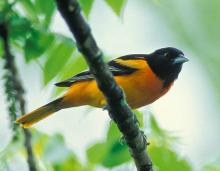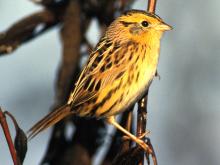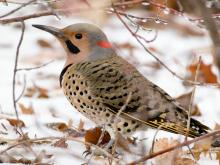Birds
Media

Species Types
Scientific Name
Dolichonyx oryzivorus
Description
The male bobolink is the only North American bird that has light feathers above and dark feathers below. In fall and winter, the male resembles the buffy and brown-streaked female.
Media

Species Types
Scientific Name
Icterus galbula
Description
Often, you'll hear the male Baltimore oriole's loud, flutelike song before you locate the bright orange singer as he moves among the boughs of trees.
Media

Species Types
Scientific Name
Ammodramus leconteii
Description
Le Conte's sparrow is one of our rarest but most colorful winter and migratory sparrows. Look for this secretive bird in brushy, grassy places such as weedy fields and prairies.
Media

Species Types
Scientific Name
Zonotrichia albicollis
Description
White-throateds have a boldly striped black-and-white crown, gray cheek, and a yellow patch between the bill and the eye. They spend winter in Missouri.
Media

Species Types
Scientific Name
Setophaga castanea (formerly Dendroica castanea)
Description
The male bay-breasted warbler is easy to identify, while females and nonbreeding males present a challenge. This species migrates through Missouri in spring and fall.
Media

Species Types
Scientific Name
Icterus spurius
Description
The orchard oriole is a common summer resident in Missouri. Males are rusty and black; females are olive green and yellowish. Look for them high in trees in places with scattered trees, especially near water.
Media

Species Types
Scientific Name
Pheucticus ludovicianus
Description
The rose-breasted grosbeak's song is a beautiful, robin-like carol. Grosbeaks are chubby birds with heavy bills used for gathering and eating beetles, seeds, and fruits.
Media

Species Types
Scientific Name
Pluvialis dominica
Description
The American golden-plover is a robin-sized shorebird that makes an incredible annual odyssey from Argentina to the Arctic tundra, a distance of over 20,000 miles. It flies through Missouri in spring.
Media

Species Types
Scientific Name
Sphyrapicus varius
Description
Their mottled back pattern camouflages them on tree trunks, but yellow-bellied sapsuckers leave behind telltale small, weeping holes in trees.
Media

Species Types
Scientific Name
Colaptes auratus
Description
America’s flickers used to be considered three different species, but in the 1980s biologists determined otherwise. Now, our eastern “yellow-shafted” flicker, the “red-shafted” flicker of the west, and the “gilded flicker” of the southwest are all considered just forms of the same species: the northern flicker.
See Also







Media

Species Types
Scientific Name
Hemaris diffinis
Description
The snowberry clearwing is a moth that confuses people because it looks like a bumblebee and flies like a hummingbird!
Media

Species Types
Scientific Name
Hyles lineata
Description
The white-lined sphinx moth sometimes confuses people because it flies, hovers, and eats from flowers like a hummingbird. The adults often fly during daylight hours as well as in the night and are often found at lights.
Media

Species Types
Scientific Name
Darapsa myron
Description
The Virginia creeper sphinx moth is common in woods and brushy areas and comes to lights at night. The larvae eat Virginia creeper and grape leaves.
Media

Species Types
Scientific Name
Perimyotis subflavus (formerly Pipistrellus subflavus)
Description
Tri-colored bats, formerly called eastern pipistrelles, are relatively small and look pale yellowish or pale reddish brown. The main hairs are dark gray at the base, broadly banded with yellowish brown, and tipped with dark brown.
Media

Species Types
Scientific Name
Myotis grisescens
Description
Gray myotises are difficult to distinguish from other mouse-eared bats. A key identifying feature of the gray myotis is that its wing is attached to the ankle and not at the base of the toes. It’s an endangered species.
Media

Species Types
Scientific Name
Myotis lucifugus
Description
The little brown myotis (little brown bat) is one of our most common bats, but populations are declining. White-nose syndrome has taken a heavy toll in northeastern states. This species is now listed as vulnerable across its range.
Media

Species Types
Scientific Name
Myotis sodalis
Description
The Indiana myotis, or Indiana bat, summers along streams and rivers in north Missouri, raising its young under the bark of certain trees. It is an endangered species.
About Birds in Missouri
About 350 species of birds are likely to be seen in Missouri, though nearly 400 have been recorded within our borders. Most people know a bird when they see one — it has feathers, wings, and a bill. Birds are warm-blooded, and most species can fly. Many migrate hundreds or thousands of miles. Birds lay hard-shelled eggs (often in a nest), and the parents care for the young. Many communicate with songs and calls.





















